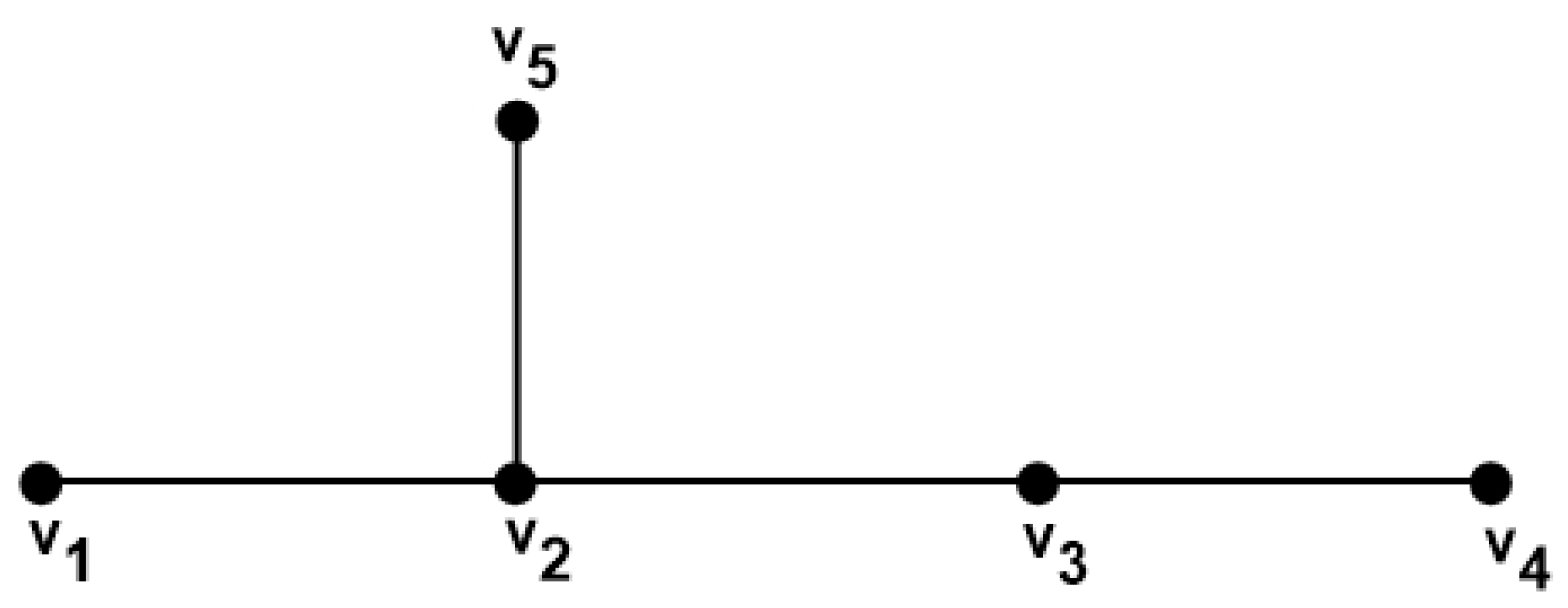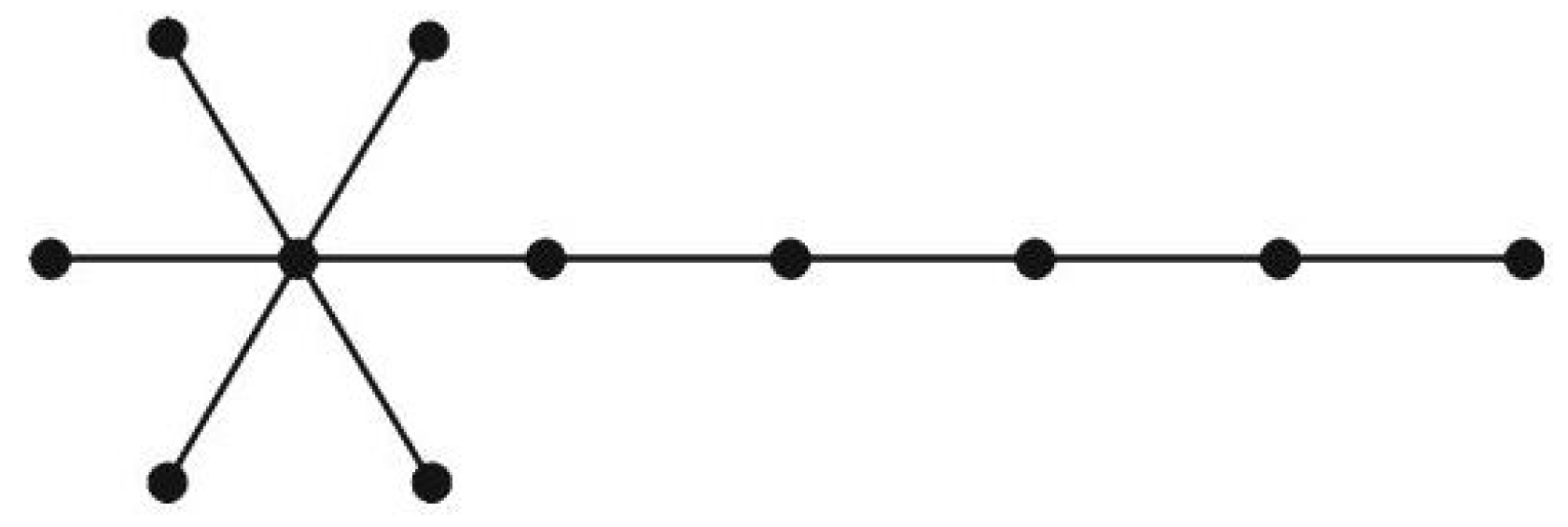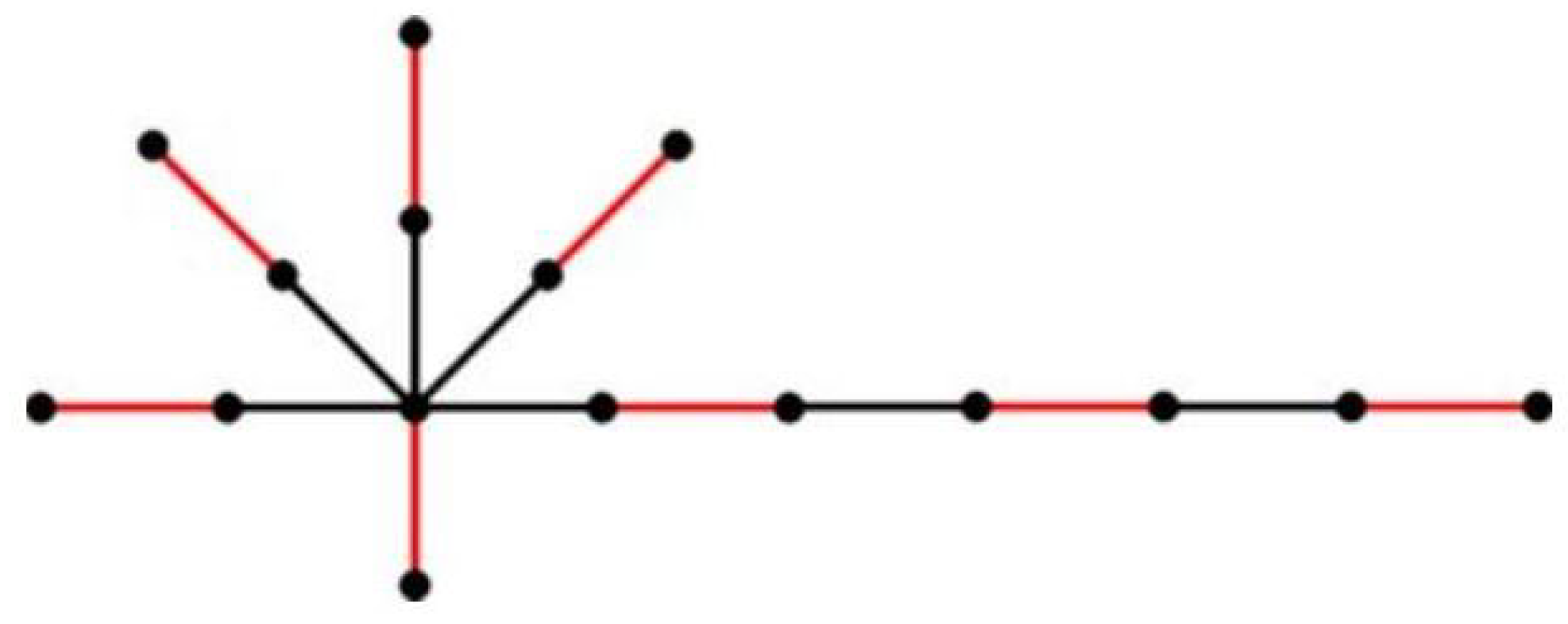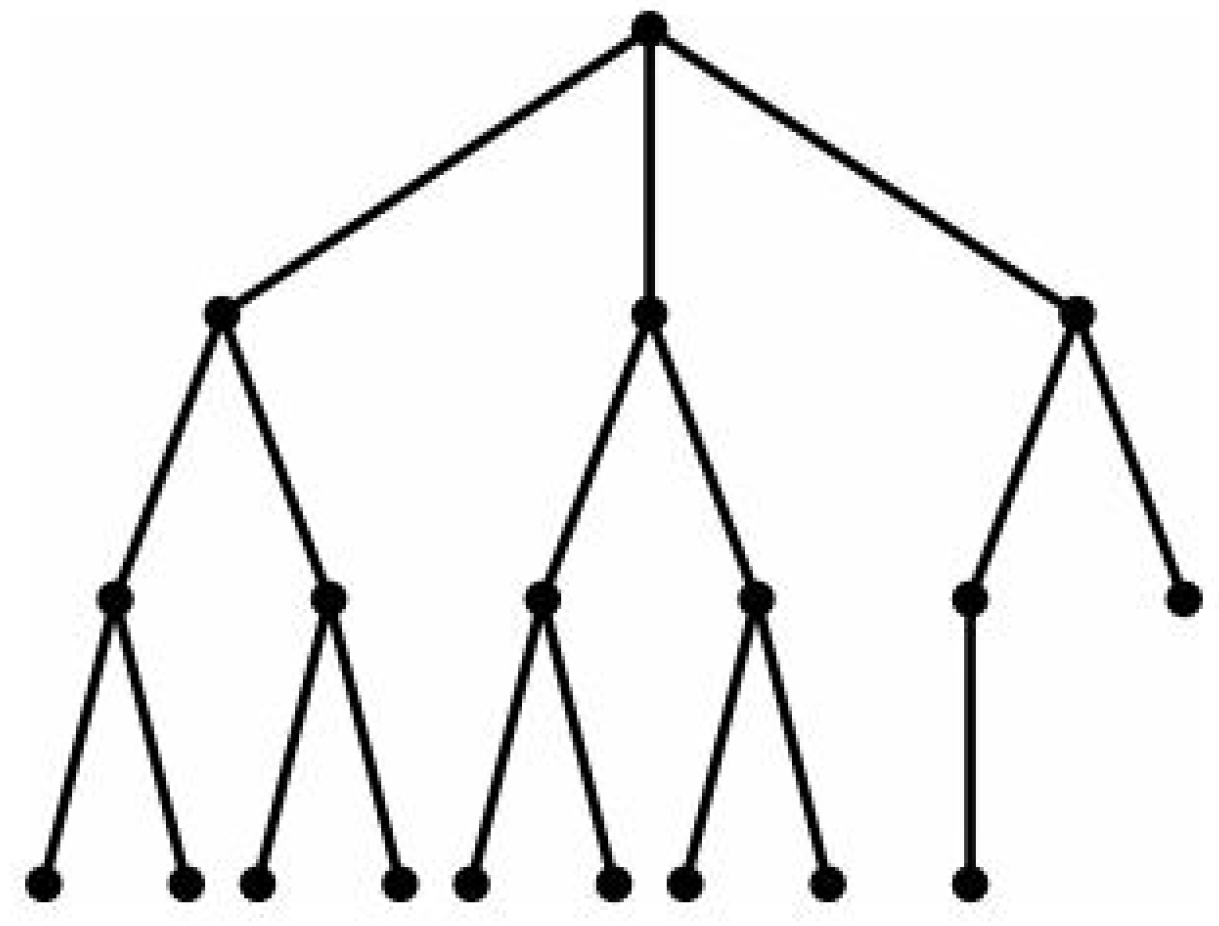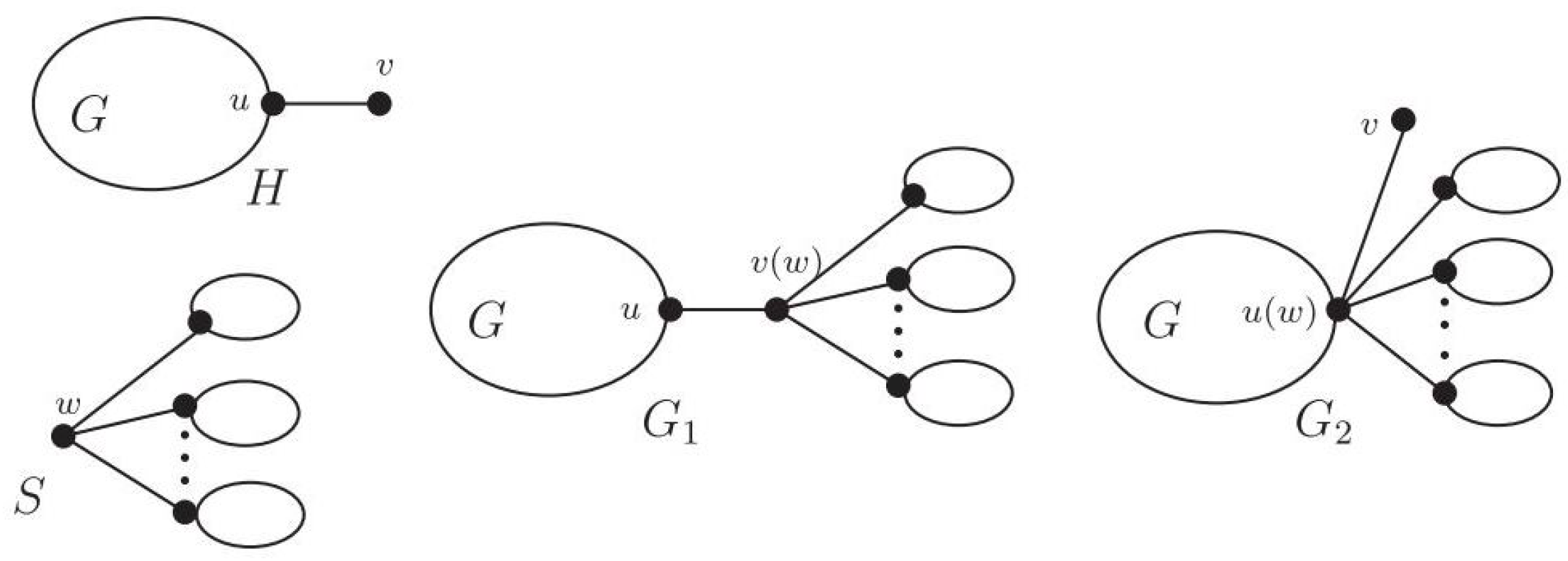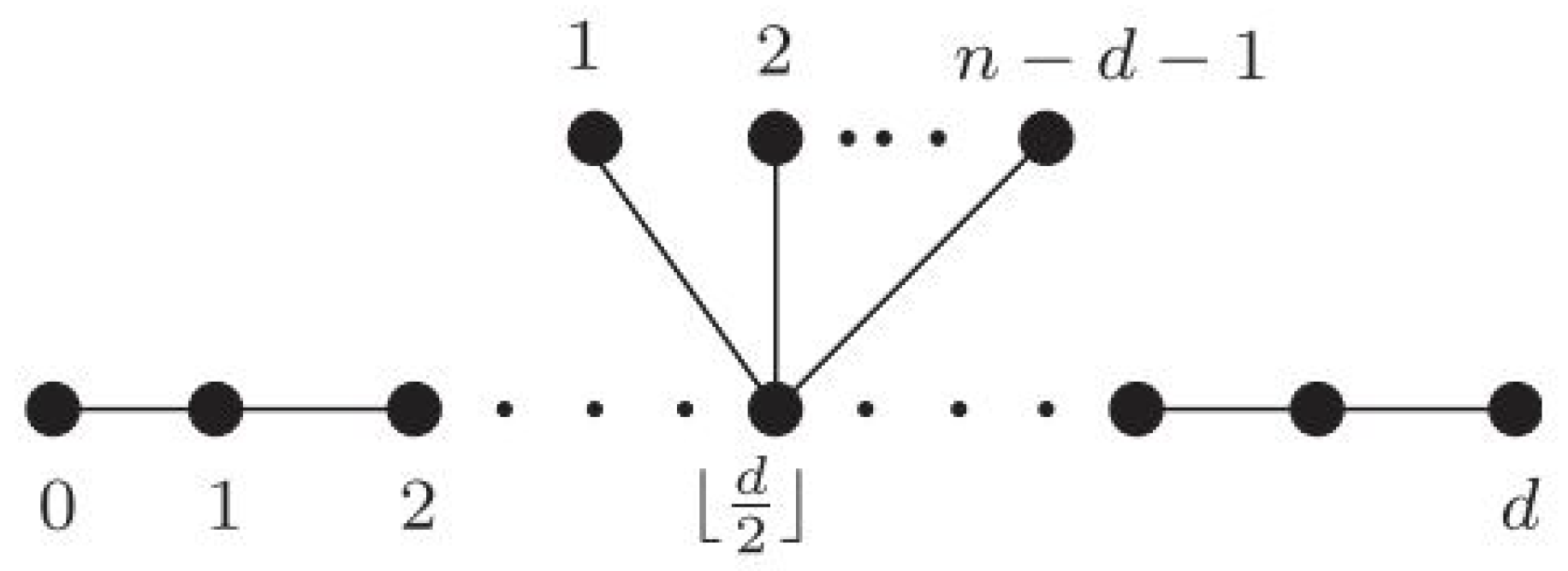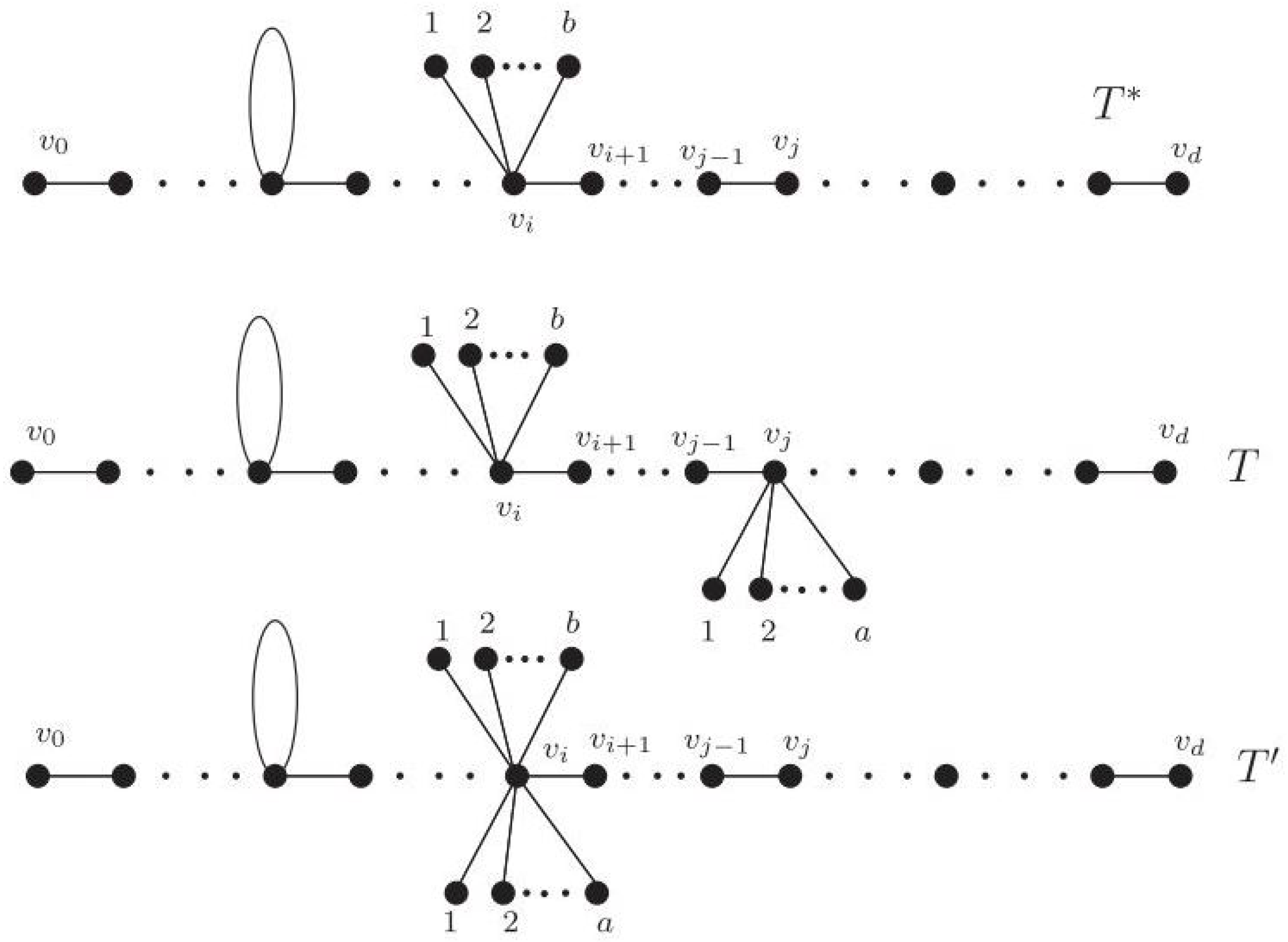1. Introduction
Let be a connected simple graph with |V|= n. Let be any two vertices of G; then, denotes the length of the shortest path connecting them, known as distance form u to v and vice versa. The number of vertices adjacent to a vertex is called degree of vertex v and denoted as . A vertex of degree 0 is called an isolated vertex and vertex of degree 1 is called an pendant vertex. Let be the maximum degree of a graph G. Let be the distance matrix of G, where . The distance matrix is a symmetric real matrix, with real eigenvalues. The diameter of a graph G is the maximum distance between any two vertices in a graph and is denoted as . For a vertex and a positive integer k, the open k neighborhood of v in a graph G is denoted by , and is simply defined as A matching M in any graph G is a set of pairwise non-adjacent edges, i.e., no two edges share a common vertex. A perfect matching is a matching that matches all the vertices of a graph.
A numerical parameter derived from a graph’s structure is called a topological index of a graph
It represents a characteristic of its topology which does not depend on the pictorial representation or labeling of a graph. These indices are widely used in chemistry to understand correlations between molecular structure and physical properties or biological activity. Distance-based topological indices are defined by a distance function. These indices can be derived from a distance matrix. For more details, see [
1] and the survey paper [
2].
Numerous distance-based topological indices have been studied in detail due to their applications in computer science and chemistry. The Wiener index [
3] is one of the most vastly researched and well-known indices, and is defined as: ing has been retained.
In 1992, another distance-based topological index was introduced by Mihulic et al. [
4], known as the Harrary index.
Nowadays, the Harrary index is defined as [
5,
6],
Further, in 1993, Randić [
7] introduced the hyper Wiener index, defined as
A new distance-based topological index called the Schultz index was introduced by H. P. Schultz in 1989 [
8]. A. Dobrynin et al. [
9] called this the degree distance index and is denoted by
.
For more details and examples of distance-based topological indices, we refer the readers to [
2,
10,
11] and the references therein.
Recently Naji et al. [
12,
13] introduced a new distance-based topological index called the
-index of graph, or the
k-distance degree index of graph. They proposed a general
-index of common graphs and provided some bounds on the
-index of graphs. In [
13], they computed and proved some results of the
-index of certain graph operations. The authors in [
14] defined some graph transformations and their impact on the
-degree distance index of a graph with respect to the pendant vertex or a path. In the same paper [
14], the authors also defined a tree with minimum
-index depending on the fixed number of pendant vertices. In [
15], these contributions make the work highly valuable for advancing both the theoretical understanding and practical applications of complex communication networks. In [
16], the authors discuss the laplacian eigenvalues of tree-symmetric networks were utilized to analyze other properties of the network.
Our aim is to build upon existing research and contribute additional findings to the
-index of graphs especially in presenting trees with maximum or minimum
-index depending on fixed maximum degree, perfect matching, and different transformations. The study of trees and generally bounded trees with maximum degrees focuses on resolving a natural problem. In
Section 1 of this paper, we just introduced some basic knowledge of distance-based topological indices and their applications. In
Section 2, we will discuss some established data to support our results in following sections. In
Section 3, we introduced some graph transformations and their impact on the
-index of graph. In
Section 4, we proved that the star graph has the minimum and the path graph has the maximum
-index among the set of all trees on
n vertices. We also show that among trees with fixed maximum-degree
, the broom graph
(consisting of a star
and pendant path of length
attached to an arbitrary pendant path of star) is a unique tree which maximizes the
-index. Further, we also defined and proved the effectiveness of a graph with maximum
-index among trees on
n vertices with fixed maximum-degree
and perfect matching. In
Section 5, we characterize the starlike trees which minimizes the
-index. We also propose a unique tree which minimizes the
-index among trees on
n vertices with fixed diameter
d.
Definition 1. For a connected graph G on n vertices, the -index of G is defined as:where Example 1. Let G be a graph with five vertices as shown in Figure 1. It is clear from the figure that
.
3. Some Graph Transformations
In this section, we propose some new results on the -index of trees in terms of the defining transformation and their impact on the -index of graphs. We start by proposing a transformation that will be used more often throughout our main results.
Theorem 1 ([
14])
. Let t be a vertex of nontrivial graph G, and let . Let denotes the graph obtained from G by connecting two pendant paths P and Q of length p and q (see Figure 2), i.e., and , respectively. Then, Lemma 6 ([
14])
. Let G and be two connected and bipartite graphs (see Figure 3), where is a pendant path at v and all neighbors of v in are switched and connected to vertex u in . If , as S is not a pendant path with end vertex u, then Lemma 7. Let u be a non-pendant vertex of G. Let be the center of the n-vertex star graph. Let and be the graphs obtained from G by identifying the pendant vertex and to vertex u (see Figure 4); then, . Proof. Let G be a connected graph and be a non-pendant vertex. Let and be the graphs obtained from G by identifying the pendant vertex and center of a star graph on n vertices to vertex u.
As we move from
to
, we see that the vertices are unchanged, i.e., the size of the graph remains the same. We see from
Figure 4 that for any
, where
. So we have
Similarly, for any two vertices and from the n vertex star graph, the distance remains the same, i.e., , where .
So, from the above arguments we have,
The result follows. □
Let G and be connected graphs rooted at u and v, respectively; then, graph is obtained from G and by identifying the root u of G with the root v of . So, by using the argument of Lemma 7, we have the following result.
Corollary 1. Let and be the bipartite graphs rooted at u and v, respectively, such that . Let be a graph rooted at vertex a; then, , where and .
4. The Maximum -Index of Trees
The broom graph
is a tree consisting of a star
and a pendant path of length
attached to an arbitrary pendant path of star (see
Figure 5). In the following theorem, we show that the broom graph maximizes the
-index among all trees on
n vertices with fixed maximum-degree
.
Theorem 2. Let be an arbitrary tree on n vertices with fixed maximum-degree Δ.
Then, Proof. Let T be a tree on n vertices and v be a fixed vertex of degree , known as a root. Let be number of trees attached at v. Now, we can apply the transformation of Theorem 1 repeatedly at a vertex of degree of at least 3, which has largest eccentricity from the root in each tree , , as long as every subtree becomes a pendant path. From Theorem 1, we see that the application of the transformation will continuously strictly increase the -index in every step.
When all the trees turn into pendant paths, we can apply the transformation of Theorem 1 at vertex v again, as long as there exits two paths with a length of at least 2, which further increases the -index. At the end of this repeated transformation, we will reach in the Broom graph. □
Let be a starlike tree obtained from the Broom graph by removing the last edge from the longest path and attaching it to one of the pendant vertex. From the above proof, we also get that has the second maximal -index among all trees with fixed maximum-degree .
Corollary 2. Let be an arbitrary tree on n vertices with fixed maximum-degree Δ.
Then, Theorem 3. Let be an arbitrary tree on n vertices and be a path on n vertices; then, Proof. Let be the tree on n vertices. We see from Lemma 3 that the deletion of an edge increases the -index; from Lemma 5, any graph will have smaller -index than its spanning tree, showing that the graph with the maximum -index has to be a tree itself.
From Theorem 2, we see that the maximum
-index is achieved by one of the Broom graphs among trees on
n vertices. If
, then we can apply the transformation of Lemma 7 on the vertex of degree
in
and obtain
Thus, we see from the transformation that
for
, which shows that
□
In [
12], the authors proved the generalized
-index for
and
for
.
Let
T be a tree and
M be its perfect match; it is well known from [
17] that the perfectly matching
M of a tree
T is unique. Let
be a
-starlike tree, i.e.,
, which has a central vertex
v, a pendant edge, a pendant path of length
, and
pendant paths of a length of exactly 2, which are all attached at central vertex
v (see
Figure 6).
Theorem 4. The tree has the maximum -index among trees with a perfect match and maximum-degree Δ.
Proof. Let T be an arbitrary tree on n vertices with perfectly matching M. Let v be a root of T and of degree . Let be the neighbors of V. Let be the maximal subtrees rooted at , such that neither of these trees contain the root v. Then, at most an order of one, the tree can be odd (if any two trees and have odd number of vertices, then their corresponding roots and will be unmatched). Actually, the number of vertices in T are even, there exists exactly one subtree among with odd number of vertices.
Using Theorem 1, we can transform each subtree
attached at
v into a pendant path attached at root
v, which will continuously increase the
-index while keeping the existence of a perfect match. Let us assume that
has an odd number of vertices, while the remaining subtrees have an even number of vertices. We may apply a similar transformation to the one in Theorem 1, but instead of moving one edge, we move two edges in order to keep the existence of a perfect match. Thus, if
, then from Theorem 1,
Using the above transformation continuously, we may reduce the tree to one vertex, to two vertices, and leave with vertices. Thus, we obtain . Since we are strictly increasing the -index all the time, we come to the conclusion that has the maximum -index among trees with a perfect match and maximum-degree . □
5. Trees with Minimum -Index
The complete
-ary tree is defined as follows. Start with the root having children. Every vertex different from the root, which is not in one of the last two levels, has exactly
children. In the last level, while not all vertices have to exist, the vertices that do exist fill the level consecutively. Thus, at most one vertex on the second-last level has a degree between 1 and
(see
Figure 7).
In [
18], the authors named these trees Voolkmann trees, as they represent chemical structure of alkanes with a minimal Wiener index [
19]. Volkmann trees also have the maximal greatest eigenvalue among trees with a maximum degree, as shown in [
20]. The maximum distance eigenvalue is known as distance spectral radius. Aleksandar Ilić et al. [
21] discussed that a computer search among trees with up to 24 vertices revealed that complete
-ary trees attain the minimum values of the distance spectral radius among the trees with the minimum vertex degree
. Based on this argument and the above-mentioned empirical observations, they conjectured that
-ary tree attains the minimum distance spectral radius among trees on
n vertices and maximum-degree
.
Theorem 5. The balanced Δ-starlike tree has minimum -index among Δ-starlike tree of order n.
Proof. Let be an arbitrary -starlike tree. In case there exists i and j such that , such that , then we can strictly decrease its -index by applying Theorem 1 repeatedly to a -ary tree until we obtain -starlike tree with paths of lengths and instead of and . □
Let be the graph consisting of the union of two stars and , with an edge joining their centers.
Lemma 8. Let , then
Proof. Let u and w be the centers of the induced subgraph , of the double star Let x be the pendant vertex we move from the center of to the center of to get graph . We observe that distance of all vertices in with x is increased by 1 while the distance of all vertices in with x is decreased by 1. As , it is obvious from the above argument that . The result follows. □
Lemma 9. Let H, S be the graphs as shown in Figure 8, where G is a connected graph with at least an edge. Let . Then, Proof. The proof follows directly from Corollary 1. □
Theorem 6. Let , then is the unique tree with the minimum -index among the set of trees on n vertices with maximum-degree Δ.
Proof. Suppose T is a tree with a minimum -index among trees on n vertices with maximum-degree . Since T is a tree with maximum-degree , we may consider that T can be obtained from by attaching a subtree at each pendant vertex of the star, respectively. From Lemmas 8 and 9, the trees must be a star with a central vertex as a root. If there are two subtrees of at least two vertices, then by Corollary 1 and the given condition , we can obtain a new tree with a smaller -index by attaching all the subtrees at the pendant vertex of , so it follows that □
Let
be the set of trees on
n vertices with fixed diameter
d, where
Let
be the tree obtained from a path of length
d by attaching
pendant vertices to the center of the path (see
Figure 9).
Clearly, we see that if is not a caterpillar graph, then by corollary 1 we can find a tree such that .
Lemma 10. Let be a caterpillar graph. Let , such that we have a pendant path from to . Let and . Let be the tree obtained from T by moving all pendant vertices adjacent to to (see Figure 10), then . Proof. Let
be the tree rooted at vertex
(see
Figure 10). Assume that
c is the center of star graph
. It can be seen that
and
. Now, it is sufficient to prove that
Applying Lemma 6 repeatedly, we see that
. As
and
, so the result follows from Corollary 1. □
Let be a caterpillar graph. If T has more than one vertex of degree with at least 3, then by repeated application of Lemma 10 we obtain a new tree with exactly one vertex of degree of at least 3, such that the new tree has the minimum -index. Let T denote the caterpillar tree with fixed diameter d such that there exists only one vertex of degree of at least 3; let us say that w is a vertex with a degree of at least 3. If is the tree with minimal -index, then by Theorem 1 it is obvious that w must be the central vertex of T, i.e., We conclude the following result from all the above discussion.
Theorem 7. Let and , then . Furthermore, 